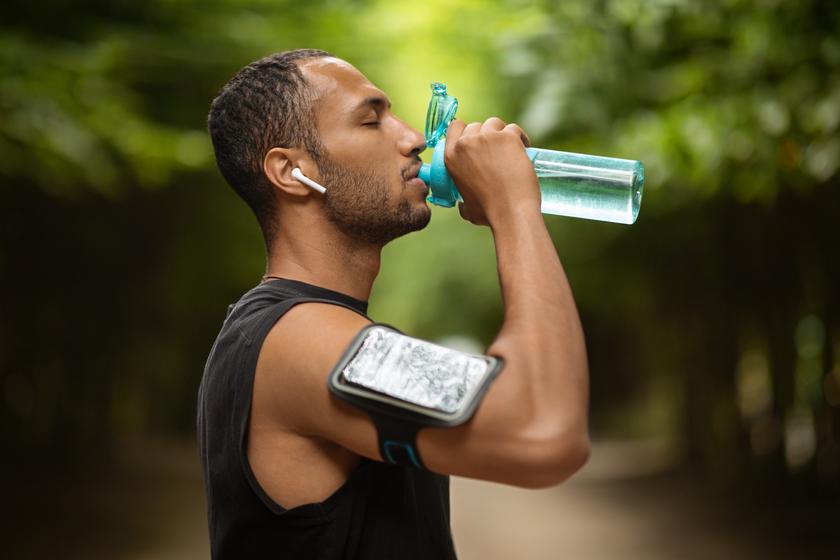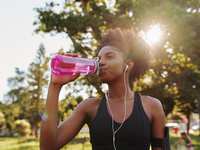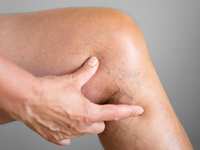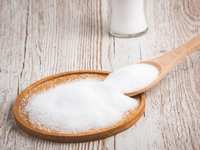How to Stay Hydrated While Running in the Heat

It's no secret that hydration plays an important role in exercise. But knowing how much water you need to stay hydrated isn't a simple matter — especially when the workout you're gearing up for is a long run in high heat.
There are a number of logical questions: Just how much water do you need to drink? When does the temperature necessitate adjusting your hydration plan? Is a sports drink or electrolyte beverage the better option?
The answers are often fairly individualized, depending on your overall health, fitness level and exercise goals. But there are several rules of thumb to help guide runners as they prepare to handle the heat.
"We want the environment we run in to be safe, which means, ideally, we run when the temperature is cool if we're running outdoors," says Dr. Alysia Robichau, a sports medicine doctor at Houston Methodist. "Your hydration needs are less when the temperature is at its coolest."
In Houston, "cool" temperatures can be hard to come by, essentially impossible during the summer months.
"When it's close to or over 100° F outside, the safest option is to run indoors on a treadmill," says Dr. Robichau. "If we're not doing that, we need to run when the day is at its coolest, which is early in the morning or late in the evening. And we definitely need to be thinking about hydration."
How does running in the heat affect you?
Exercise raises your body temperature. Exercising in hot weather can raise it even higher, often rapidly.
"And it's not just the temperature you need to keep an eye on," says Dr. Robichau. "It's the humidity, the sun and your environment. How much of your run is shaded versus unshaded? These are all factors to consider."
Your body deals with conditions like these by sweating, its natural mechanism for cooling. As sweat evaporates from your skin, body heat is released.
There's a tradeoff, though: Losing sweat means losing water, which your body not only needs as it continues to cool itself down but also for the many other critical roles it plays, from energy production and blood flow regulation to joint lubrication and preventing leg cramps.
"Heat alone can make a person sweat more than usual, so you're absolutely going to need to think about water when running in the heat," says Dr. Robichau.
And we don't just lose water as we sweat, we also lose electrolytes — sodium and potassium, in particular.
"Electrolytes help ensure that the water you drink goes to the right places in your cells where it can be used," explains Dr. Robichau. "If our electrolyte levels are low, water can't get where it needs to be. Instead of hydrating you, the water you're drinking collects where it's not needed. So you might notice puffy hands and feet or bloated belly, but you won't actually feel hydrated."
It's why maintaining adequate hydration while you're exercising in the heat is sometimes also about replenishing electrolytes, too.
5 tips for staying hydrated on a run when it's really hot outside
Dr. Robichau recommends using a treadmill when temperatures climb toward and beyond the 100s, but many runners will still opt to head out into the heat.
"Running when it's dark outside can help make staying hydrated a little easier, but specific adjustments will still need to be made," explains Dr. Robichau.
Here are five hydration tips for running in the heat:
1. Start your run already well hydrated
To get this right, it's critical to understand the hydration basics. Whether you're exercising or not, you should aim to drink about eight to 10 glasses of water daily, spread evenly throughout the day.
It's especially important to meet this goal on days you plan to exercise.
"If you're already behind on your daily hydration, you're going to be playing catch up in whatever it is you plan to do," warns Dr. Robichau. "Playing catch up while running in the heat isn't a good idea since that's an easy way to become dehydrated and overheat."
To keep tabs on your hydration status throughout the day, simply check your urine. The darker or more odorous your urine, the more you're behind.
2. Go to sleep hydrated and swap coffee for water if you're going for a morning run
If you choose to run first thing in the morning, you might wonder how to go about actually starting your run hydrated. You've been asleep — and therefore not drinking water — for several hours, after all.
"First, you can make sure you go to bed well hydrated," says Dr. Robichau. "Not to the point that you're having to wake up in the middle of night to go to the bathroom, but enough that your urine isn't bright yellow and you're really having to catch up the next morning."
Getting up at least 30 minutes before your run to start your hydration process early can help, too, but — if you're not much of a morning person — Dr. Robichau says you shouldn't be afraid to just drink a bottle of water before heading out the door.
"Getting some water in you is key, however you do it," Dr. Robichau adds. "That might mean swapping that cup of coffee you usually have first thing in the morning for a glass of water."
3. Bring water if you're running longer than 20 minutes
In 70-degree weather, you can get away with going waterless on a three-mile run. When it's really hot outside, you can't.
"You need to be thinking about hydration just because of the heat alone — even before taking things like your speed or distance into account," explains Dr. Robichau. "For the average runner, anytime you are outside longer than 20 to 30 minutes, you need to bring some sort of hydration with you — taking sips every 10 minutes or so."
For those worried about overhydrating, Dr. Robichau puts things into perspective.
"A lot of endurance runners worry about hyponatremia because that's what is in the news, but it's actually not something we typically worry about with everyday training," explains Dr. Robichau. "Hyponatremia is usually a problem on race day itself, when water station after water station tempts people into changing their usual hydration plan. They end up drinking too much and flushing out electrolytes."
4. Add electrolytes if you'll be sweating a lot
A hot run is usually a sweaty one. Does that mean you automatically need to opt for a sports drink or another type of electrolyte-containing beverage instead of water?
"If you're planning to run more than five miles, and especially for those 10-, 15- and 26-mile runs, your hydration should contain electrolytes," says Dr. Robichau. "You can still add electrolytes if you're running less than that, but just drinking water isn't always as much of a worry."
That is, unless you think you'll be sweating for a long time — regardless of the distance you're running. For instance, if you're running less than five miles but you're sweating longer than an hour, it's a good idea to consider an electrolyte beverage.
"It's the amount of sweating that makes the difference," says Dr. Robichau.
Options for getting electrolytes include:
- Sports drinks
- Electrolyte tablet or powder added to your water
- Electrolyte gels
"You can make your choice based on what your stomach tolerates best," says Dr. Robichau. "Electrolytes gels and full-sugar sports drinks can cause upset stomach for some people."
5. Monitor your urine color and adjust accordingly next time if needed
When it's all said and done, past experience can also be a useful hydration guide.
"Checking your urine color is probably the easiest way to assess your hydration status and determine whether you remained hydrated," says Dr. Robichau. "If your urine is bright, bright yellow after your run, you're dehydrated."
You'll need to do something different the next time, whether that's making sure you start your run well hydrated, bring more water with you or add electrolytes.
"If you're training for a half-marathon or marathon, we might want to get more analytical and measure your weight before and after a long training run," adds Dr. Robichau. "This can help determine how much water you typically lose, so you know about how much you should aim to replace."
Be aware of the signs of heat stroke — which is a medical emergency
Why is it so critical to get your hydration right when you're running in the heat? It can help prevent heat exhaustion, which comes with uncomfortable and concerning symptoms of its own, but it can also progress into heat stroke — a medical emergency.
"The main difference between heat exhaustion and heat stroke is mental status changes," says Dr. Robichau. "You can be hot, drowsy and not feeling well and that's heat exhaustion. And, yes, you need to seek shade and rehydrate in that case. But if you get to the point where you're having hallucinations, are confused, not able to stay awake or passing out, that's heat stroke, and you must go to the hospital."
Heat stroke symptoms include:
- A body temperature of 104 degrees F or higher, as measured by a rectal thermometer
- Sudden confusion or hallucinations
- Difficulty walking
- Seizures
- Fainting
If you or someone around you is experiencing heat stroke symptoms, call 911.

















